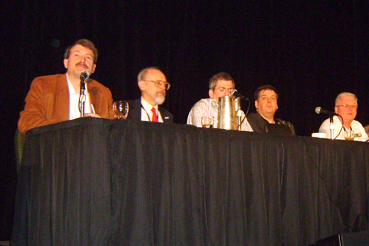Post-transition Issues Persist

RANCHO MIRAGE, CALIF: The DTV transition merely appears to be completed. Bedevilment remains in the details, several broadcasters said this week at the HPA Tech Retreat. (At left, L-to-R: Bob Seidel of CBS, Art Allison of the NAB, Richard Friedel of Fox, Thomas Bause of NBCU, Bob Allen of KESQ, and not shown to his left is Jerry Butler of PBS.)
Thomas Bause, digital video engineer for NBC Universal, said adoption of Active Format Description by cable operators was “disappointing.”
AFD provides information for TV sets to properly display images in either 4:3 or 16:9. It’s transmitted in the MPEG video stream.
Richard Friedel, executive vice president and general manager of Fox Network Operations said AFD also appeared to be a continuing problem at the station level. He said Fox was unique in that it did all of its ATSC encoding at the network and transmitted the related metadata to some 200 or so affiliates. Around half had issues with the DTV transition, and 50 still do, he said.
“One of the biggest problems is excessive PCR jitter,” he said, referring to Program Clock Reference issues involving buffer management. PSIP also remain a problem as well as AFD. Friedel referred station engineers to ATSC A/78. Dialnorm is an ongoing issue, he said.
Bob Allen later questioned whether some of these problems originated with stations. Allen is executive vice president and general manager of KESQ-TV in Palm Springs, sister to Fox affiliate KDFX-CA. Allen said some of the issues Friedel mentioned were being encountered by DirecTV by Fox affiliates across the country. They determined to compare notes later.
Jerry Butler, senior director of the Interconnection Replacement Office for PBS, said reception remained problematic for member stations that hadn’t applied for maximization.
“Others are having ingress problems at cable head-ends,” he said. Atmospheric induction appears to be responsible for bringing in out-of-market signals in these cases.
Art Allison of the NAB was part of the panel discussion. He brought up the developing schism between broadcasting and broadband and said the two would be better off as complimentary services.
“IP is quality challenged, entrenched in one-to-one trial-and-error synch,” he said. “I have yet to see true HD online,” but the public acceptance bar of what passes for HD is very low. “The combination of on-air and online video delivery is better than the two trying to kill each other.”
The FCC is leaning otherwise; tossing around the idea of reallocating broadcast spectrum for wireless broadband.
Allison said, “The spectrum allocation model was flawed. No multiple interference models were used,” only single ones.
Robert Seidel of CBS was more succinct:
“One of the single largest users of spectrum is the federal government, so I’d say to them, ‘check your own house before you come to ours.’”
CBS, ever vigilant about the quality of its HD signal, has been conducting post-DTV transition signal flow tests to check for pre-filtering and other introduced anomalies. Seidel said there has been incorrect color conversion to NTSC, clipping of deep blacks and bright whites; lip-synch errors and front and rear audio phase-out.
At the network level, Seidel said that CBS put all the Super Bowl ads through the ITU BS.1770 dialnorm algorithm, but that advertisers were also given the chance to remix. One elected to do so.
All the panelists were later asked about plans for 3DTV. Bause said NBCU was looking at partners on the broadcast side and parsing a strategy. Friedel said Fox would do the NBA All Star Game in July in 3D. Seidel said CBS would contribute upconverted 2D-to-3D content for DirecTV’s 3D channels launching later this year.
“The question for broadcasters is where the bits will come from, even if we had a standard, which we don’t,” Seidel said. “Most stations are using their bits, unless the cable operators want to give me another channel out of the goodness of their hearts.”
-- Deborah D. McAdams
The professional video industry's #1 source for news, trends and product and tech information. Sign up below.
